3-2 Gross and Fine Motor Skills
A – Motor Development
Motor development is characterized in three ways:
- Embodied (constrained by the body’s maturation)
- Embedded (constrained by the environment)
- Enculturated (constrained by what’s acceptable or encouraged in an individual’s culture)
One way to see the embodied effects of motor development is in the pattern of motor development, which can be characterized as stepwise, or not smooth. Motor development advances much like physical development. It’s not on and off like a faucet. It advances more like a river, with ebbs and flows.
For example, a child doesn’t begin to walk one day and then continue walking every moment. A child may take a few steps and then return to crawling, then try walking a few steps again the next day.
Physical development is also not a continuous growth curve. Growth happens in jumps and starts.
A child can grow three-quarters of an inch in one day. Imagine if you grew that fast. You’d eventually realize you had grown so much when you started hitting your head on everything, just like children do.
Let’s review the three characteristics of motor development.
Embedded and Enculturated
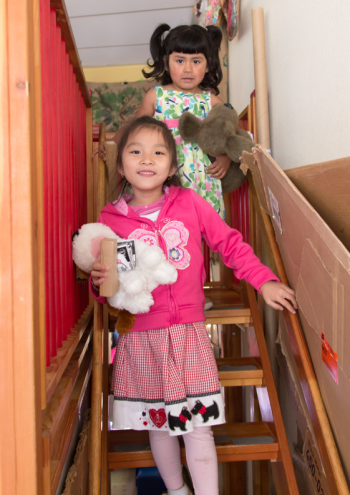
A child who grows up in a home with a set of stairs will learn how to climb and descend stairs earlier than a child who does not have those experiences (embedded).Motor development is embedded and enculturated.
Children who grow up in a culture that practices early motor movements, such as holding infants upright, supported, while bouncing their feet on the ground, will begin to walk earlier than infants in a culture that does not provide motor enrichment (enculturated).
As long as they are physically able to, all children will eventually learn to climb stair-like structures. All children will eventually learn to walk. The age at which walking or other motor behaviors develop and the order in which different motor behaviors develop can vary widely depending on the environment in which children’s development is embedded and the culture in which children live.
Embodied Development
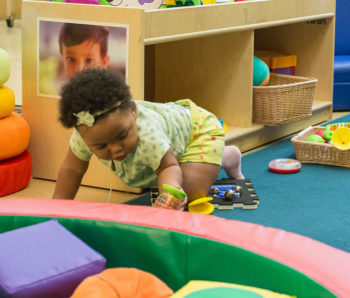
Motor development is also intricately connected to perception. This is one way that development is embodied. It is constrained by your perceptual and physical abilities.
Infants are initially limited to lying face up or face down with little to no control about what they get to look at. If something interesting is in the corner of their vision, they can’t move themselves to look at it. They have to cry and wait for an adult to place them in a suitable viewing position.
Learning to sit gives children a much better perspective on what is around them but still limits their ability to explore, since they can see the objects from afar but have no way to move toward them.
Learning to crawl or walk allows infants to not only see what they want to see but also to get different views and even reach and handle the objects.
Infants who are walking cover more distance than non-walkers (even fast crawlers). They can see more objects, and they are able to engage with more people since they can walk right up to them to get their attention.
In other words, children have a lot of intrinsic motivation to learn to move around their world effectively.
Visual Motivation
Some scientists believe that vision is one of the key motivators for children’s engagement in exploration and motor practice.
They think this because they have found that children with congenital blindness are very delayed in developing manual actions such as reaching, despite actively responding to objects that make sounds.
Researchers take this as evidence that visual input is a strong motivator of reaching behaviors in infants.
Vroom Tip
Check out this Vroom tip to get more ideas about how to support motor development.
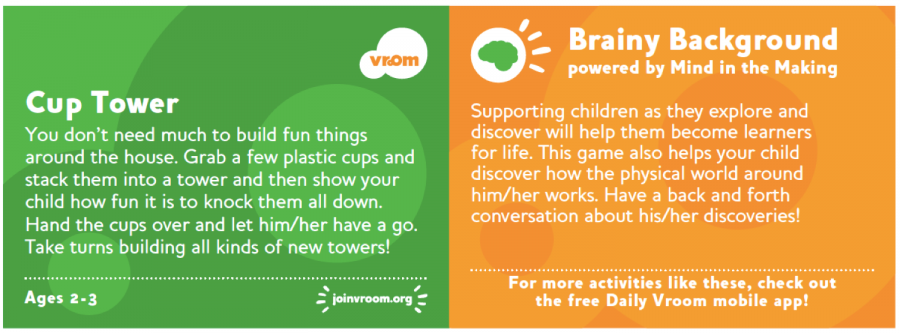
View text-only alternative of this Vroom card
Cup Tower
You don’t need much to build fun things around the house. Grab a few cups and stack them into a tower and then show your child how fun it is to knock them all down. Hand the cups over and let him/her have a go. Take turns building all kinds of new towers!
Ages 2-3
Brainy Background powered by Mind in the Making
Supporting children as they explore and discover will help them become learners for life. This game also helps your child discover how the physical world around him/her works. Have a back and forth conversation about his/her discoveries!
What do you think of this idea? Does this tip make sense in the context of an early learning environment? And if not, how might educators adapt the activity to better fit that environment?
B – Gross Motor
Large Muscles
Muscle development and sociocultural factors both affect the trajectory of motor development.
How do children get from one state of motor development to the other in such a short period of time? They do this all while their internal and external worlds are constantly changing due to changes in body size and weight and a broadening range of perceptual abilities, such as vision and audition.
A lot of motor development is based on muscle development. If you have enough muscle to move a part of your body, you can do it. If you don’t, you need to build more muscle, or at least a higher muscle-to-fat ratio.
But having the muscle is not necessarily enough. The age that different motor abilities develop varies greatly across the world. It is greatly affected by sociocultural factors.
For example, in some cultures, such as the West Indians of Jamaica, parents promote walking by standing infants in adults’ laps and bouncing them on their feet. These children tend to walk considerably earlier than North American children, who are predominantly laid on their backs or on their bellies.
Crawling
Generally speaking, infants go from lying to rolling, to sitting, to standing, to walking. You may notice that crawling was not included in that list; crawling is not a necessary step in the development of gross motor movement This omission was intentional for two reasons:
- The act of crawling is highly variable across and within cultures. Dr. Myrtle McGraw put it best when she said, “No other neuromuscular function of the growing infant exhibits greater individual variations in pattern [than crawling].”
- Some individuals and some cultures skip crawling altogether. It is not a necessary stage in the development of locomotion. In fact, the West Indian infants of Jamaica often skip crawling altogether. And many cultures across the world carry their infants until they are able to walk on their own.
Some anthropologists have even proposed that crawling may be a novel invention of Western nations in which families had safe and clean floors to place children. In many other cultures and locations, it is simply unsafe or unsanitary to place infants on the ground face down.
Perhaps surprisingly, children who do go through a crawling phase prior to walking experience no benefit. In fact, children who skip crawling altogether may walk earlier than those who spend time crawling before they walk.
No benefit to crawling
You might be asking yourself how there is no benefit to crawling before walking. Surely children learn properties about movement across different types of ground and inclines that transfers to walking.
But actually, scientists have found that there is little to no transfer of learned information between crawling and walking. Infants appear to treat walking as a completely new action that has no relation to crawling.
When first learning to walk, even children who have previously crawled have to re-learn how to navigate ground with different heights, slopes, etc.
Standing
Another common, but not required, precursor to walking is standing.
The process of learning how to stand on one’s own can take months to develop and may sometimes even develop after walking has begun. Some children find it easier to stay upright while in motion than while static.
At about 7 months, children often begin to pull up on tables and chairs. In the beginning, they primarily use their hands and arms to lift themselves and will gradually learn to shift more and more weight to their feet.
During this time, they will often fall as many as 32 times per hour. So why do they do it? Remember, they do it to move more, see more, play more, and interact more.
C – Visual Cliff
Scientists have used the visual cliff, a fake drop-off, to demonstrate that children must first acquire experience in a new body position to react to depth cues accordingly. Scientists have studied how children learn to crawl and walk using the visual cliff.
The visual cliff is essentially a climbing area with a fake drop-off. Scientists started with a structure that has what appears to be a deep drop-off—it actually is covered by a clear, plastic cover to keep infants from injury. It appears, though, that if you walk off the edge, you will fall down a considerable height (for an infant).
What researchers found is that infants who have been crawling or walking for a while avoid the drop-off, while infants who have not been crawling for long go right over what would be a drop-off if not for the clear screen.
Fear of falling?
Originally, scientists described this avoidance as infants fearing the drop-off, but it has since been shown that infants are not in fact afraid of the drop-off at all. They show no negative emotions when encountering it.
Many infants in this situation will instead figure out alternative ways to get around the cliff, such as holding on to an edge around the clear area to skirt around it.
But just as mentioned previously, infants who avoid the drop-off when crawling, will not avoid the drop-off when walking until they’ve accrued experience in the walking posture.
Video: The Macroscope: Babies on the Brink (5:31)
Here is a short video about Dr. Karen Adolph’s work using the visual cliff. Watch as she shows us how she has used the visual cliff to examine how infants learn how to move their bodies.
This video will help give you a better idea of what exactly a visual cliff is and how researchers can use it to study infants’ and toddlers’ gross motor development.
Watch The Macroscope: Babies on the Brink from Science Friday on YouTube.

Video Debrief
Here are some of the important takeaways we took from the video about infants and physical drop-offs:
- Infants spent most of their time near the drop-off.
- Their faces were neutral or positive.
- Their approaches changed as they learned different ways to move. Eventually, as they perfected one type of movement, they could tell about as well as adults if a drop-off was safe to navigate.
- Once those same infants learned a new skill—perhaps a crawling infant learned to walk—they would walk right over the edge of the drop-off.
- They are learning to understand the relationship of their bodies and their environment.
D – Fine Motor
Small Muscles
Over the first year of life, as infants begin to be able to stabilize their bodies in ways like sitting and standing to free their hands for exploration, they start to develop fine motor skills, such as manual coordination and dexterity.
Two important manual exploration concepts are:
- Grip aperture: how wide you open your hand when reaching for an object
- Hand orientation: the position of your hand, palm, etc., relative to the object you are reaching for
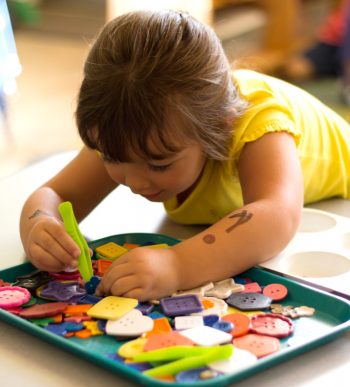
Coordinating these two skills takes time, and children only begin to coordinate them effectively to reach objects by the age of 1 year.
This is important to note because many of the tool-use skills that adults try to encourage infants to do require this kind of coordination. Tool use takes many forms, such as hammering, turning, and pulling.
All these actions require specific hand orientation and grip-aperture planning to be effective.
Reaching and Posture
We’ve covered infants’ ability to walk and grab an object, but what if they need to reach for an object?
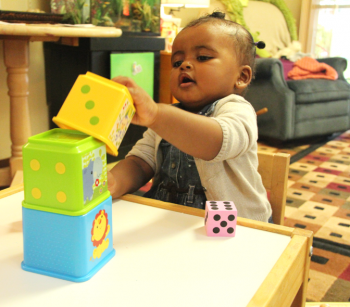
It may appear as if reaching and grasping would develop together, but in fact, reaching requires not only being able to control your hand movement but also the ability to coordinate your hand movement with your body posture.
You have to be able to hold yourself up without your hands, and hold your body steady as you extend out your arm.
Studies in which infants’ bodies were supported while they reached highlight this distinction. Scientists found that infants’ reaching behavior actually develops before their ability to maintain their posture is fully developed. So they can actually extend their arm in a reaching action well before they can actually reach for an object without someone supporting their body.
Reaching and Muscles
Infants’ reaching behaviors depend on muscle control and can often take time to develop precision. Infants’ reaching path is at first very uncoordinated. The path is often up to four times longer than the distance needed to reach the object, usually taking twists and turns in random directions.
Some scientists believed that infants were correcting their reaching paths by visually guiding the reaching path, which caused the meandering in their reaches. Surprisingly, they found that the meandering occurs even if children cannot see their own reaching hands.
This suggests that infants are not correcting their reaches using visual guidance but instead have difficulty controlling their reaching arms.
Children’s reaching behavior with their feet supports this idea. Infants presented with interesting toys from birth first show reaching behaviors with their feet rather than with their hands at as little as 2 months of age.
Physically, this makes sense. The hip joint is much less mobile than the shoulder joint, and leg muscles tend to be stronger than shoulder and arm muscles. Both these factors make it easier for infants to control the movement of extended legs than extended arms.
This evidence supports the idea that infants are able to reach at quite young ages but take a while to develop the motor control necessary to complete an arm reach.
 References
References
Adolph, K. (2008). Learning to move. Current Directions in Psychological Science, 17(3), 213–218.
Adolph, K., et al. (2012). How do you learn to walk? Thousands of steps and dozens of falls per day. Psychological Science, 23(11), 1387–1394.
Adolph, K., Kretch, K., & LoBue, V. (2014). Fear of heights in infants? Current Directions in Psychological Science, 23(1), 60–66.
Adolph, K., & Tamis‐LeMonda, C. (2014). The costs and benefits of development: The transition from crawling to walking. Child Development Perspectives, 8(4), 187–192.
Berger, S. E., Theuring, C., & Adolph, K. E. (2007). How and when infants learn to climb stairs. Infant Behavior and Development, 30(1), 36–49.
Berk, L. (2013). Child development (9th ed.). Pearson.
Brambring, M. (2007). Divergent development of manual skills in children who are blind or sighted. Journal of Visual Impairment & Blindness, 101(4), 212–225.
Galloway, J. C., & Thelen, E. (2004). Feet first: Object exploration in young infants. Infant Behavior and Development, 27(1), 107–112.
Gibson, E., & Walk, R. (1960). The visual cliff. Scientific American, 202, 64–71.
Karasik, L., Adolph, K., Tamis-LeMonda, C., & Bornstein, M. (2010). WEIRD walking: Cross-cultural research on motor development. Behavioral and Brain Sciences, 33(2-3), 95–96.
Kretch, K., & Adolph, K. (2013). Cliff or step? Posture‐specific learning at the edge of a drop‐off. Child Development, 84(1), 226–240.
McGraw, M. B. (1945). The neuromuscular maturation of the human infant. Columbia University Press.
Science Friday (SciFri). (2016, April 6). The macroscope: Babies on the brink. [Video]
Vroom. (2017). Tools and resources. [Website]
EarlyEdU Alliance (Publisher). (2018). 3-2 Gross and find motor skills. In Child Development: Brain Building Course Book. University of Washington

